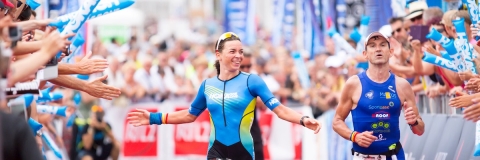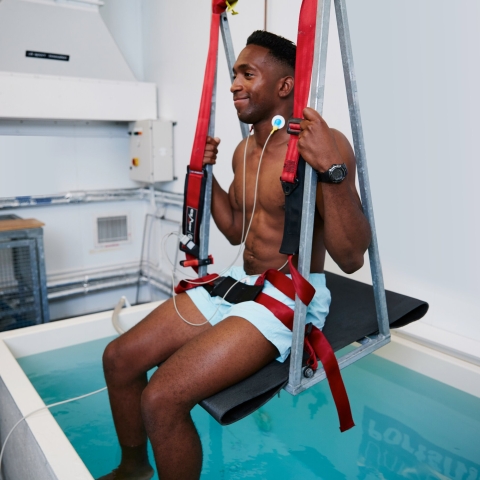
Sidebar navigation

Test your endurance
Location: Spinnaker Building
Our combination of unique facilities and expertise in sports performance testing can help prepare you to perform in any environment, identify your strengths and weaknesses, monitor and guide your training, and improve your performance.
Our sports and human performance testing is conducted in our Human Performance Unit. You'll be in safe hands when you undergo testing with us. We're experts in performance analysis in sport and environmental physiology. And our extreme environments facilities are some of the best in the UK. We work with athletes and adventurers at all levels, from amateurs to Olympic champions and Ironman triathletes.
We led the development of the British Association of Sport and Exercise Science guidelines for individuals performing in hot environments, and follow the guidelines in our sports testing and research.
Explore our facility

Assess physiological health
Our facility can help identify your strengths and weaknesses, and which sorts of endurance events you might be more suited to. We can also identify your optimum training zones at which you perform your best.

Practice heat acclimation
Heat acclimation (or acclimatisation) is the improvement in your ability to perform in the heat from repeated exposure to high temperatures, as our ability to perform prolonged exercise is impaired in hot environments. Our facility can help your body adapt to perform in the heat.

Prepare for extreme environments
We can help you perform in different extreme environments. If you're training for an endurance challenge in extreme weather, let us help you train and find out what you need to do to achieve your peak performance under trying conditions.
Equipment, amenities and tests
During the sub-maximal test, we assess your physiological responses to different work rates you might use in training and competition.
Using this test, we can determine several physiological factors which influence your exercise performance:
- Lactate threshold – The lactate threshold represents the transition between easy and steady exercise. It's an important determinant of sustained exercise performance. The best endurance athletes are able to exercise at very high work rates before reaching their lactate threshold.
- Lactate turn-point – A second sustained increase in lactate accumulation. Beyond this point, your body rapidly fatigues.
- Exercise economy/efficiency – This describes the amount of oxygen or energy required to cover a given distance, and is one of the best predictors of performance. Exceptional economy is one of the key characteristics of successful East African distance runners.
- Maximal heart rate – This is the upper limit of what your cardiovascular system can handle during exercise. We use this – along with your blood lactate data – to identify your heart rate training zones so you can guide and monitor your training.
- Substrate utilisation – This is the rate at which your body uses fat and carbohydrate during exercise. We can identify the exercise intensity at which the highest rate of fat oxidation, or fat burning, occurs. This is known as FatMax.
How it works:
The sub-maximal exercise test is conducted in 5 to 9 stages. Each stage is 3 minutes long. The work rate is increased at the end of each stage. Ideally, you will be able to complete between 5 and 9 stages. You will need to put in a hard effort, but not maximal effort.
During the last 30 seconds of each stage, we record your average heart rate and oxygen uptake.
After the stage ends, we collect a finger-prick blood sample. If you are cycling, you will continue to exercise while the blood sample is obtained. If you are running on the treadmill, you will place your hands on the guard-rails at the side of the treadmill and lift your legs clear so that they are astride the moving belt while the blood sample is obtained.
The test will end when your blood lactate concentration exceeds a predetermined value (4 mmol.L-1).
Before commencing the exercise tests, your height and mass will be measured and you will be fitted with a heart rate monitor (chest strap) and face mask for monitoring your breath.
You'll be encouraged to undertake a light warm-up before commencing the exercise test. If you do both exercise tests (sub-maximal and maximal), you will have a short 20 minute break between them.
You'll exercise either running on a treadmill or cycling on a stationary bike. You'll start at a work rate that feels easy for you, getting progressively harder until you reach the limit of your tolerance. The starting work rate will be determined in consultation with the scientist running the test and will be based on an estimation of your fitness level.
We'll use the maximal incremental test to measure your physiological responses to different exercise intensities. In this assessment, you'll exercise up to the point at which you can no longer continue, known as 'volitional exhaustion'.
Using this test, we can determine:
- Your ventilatory threshold (VT) – VT represents a disproportionate increase in breathing as exercise intensity increases, and occurs at a similar intensity to your lactate threshold. We measure VT in a non-invasive way.
- Maximal heart rate – This is the upper limit of what your cardiovascular system can handle during exercise. We use this to identify your heart rate training zones so you know your own limits.
- Your VO2max - The fastest rate at which your body can use oxygen to produce energy. A high VO2max is a pre-requisite for success in endurance type events. The best endurance athletes tend to have the highest VO2max values.
How it works:
We will progressively increase the work rate on the treadmill or stationary bike with the aim of bringing you to the limit of your exercise ability (volitional exhaustion) in 8 to 12 minutes. You will need to give maximal effort.
3 minutes after the end of the test, we collect a finger-prick blood sample to determine your blood lactate concentration.
Before commencing the exercise tests, your height and mass will be measured and you will be fitted with a heart rate monitor (chest strap) and face mask for monitoring your breath.
You'll be encouraged to undertake a light warm-up before commencing the exercise test. If you do both exercise tests (sub-maximal and maximal), you will have a short 20 minute break between them.
You'll exercise either running on a treadmill or cycling on a stationary bike. You'll start at a work rate that feels easy for you, getting progressively harder until you reach the limit of your tolerance. The starting work rate will be determined in consultation with the scientist running the test and will be based on an estimation of your fitness level.
During this assessment, we determine your body composition, also known as your kinanthropometry or Restricted ISAK Profile.
Body composition affects your strength and agility. Kinanthropometry is the science that deals with measuring body composition.
Your kinanthropometry profile will consist of a restricted anthropometric assessment. We will measure skinfold thickness at 8 different sites across your body, using a set of skinfold callipers and basic measurements of mass, stature and girth (arm, waist, hip and calf).
Your kinanthropometry profile will show your somatotype (classification of body, shoe and physique type), body fat percentage, body mass index, and waist to hip ratio.
We use the finger-prick blood samples to determine the oxygen carrying capacity of your blood. Being able to carry a lot of oxygen in your blood is particularly important for prolonged exercise.
Haemoglobin is the protein molecule in red blood cells that carries oxygen from the lungs to the body's tissues. The haematocrit blood test determines the percentage of red cells in your blood, and shows your blood's oxygen carrying capacity.
We will help your body adapt to the effects of high temperatures on your sports performance. During the session we will monitor your body temperature, heart rate, fluid loss and sweat rate.
During the session, we will monitor your:
- Body temperature
- Heart rate
- Fluid loss
- Sweat rate
You’ll exercise in a hot environment to elevate your deep body temperature to approximately 38.5°C. Your temperature will be maintained at this level for approximately 60 minutes.
You’ll exercise either running on a treadmill or cycling in an environmental chamber where the ambient conditions are controlled at 40°C and 50% Relative Humidity (RH) – although we can simulate the heat and humidity conditions of the location where you'll do your challenge.
You’ll be supervised by a sports scientist throughout the session.
By undergoing up to 5 sessions with us, you can improve your heat tolerance and prepare for a challenge in intense heat like the Marathon des Sables.
We can replicate conditions in the Arctic, Antarctic, deserts, jungles, high-altitude zones and cold-water exposure. To participate in these performance tests, you must be fit and healthy, and familiar with maximal exercise. We will determine your fitness and health using a health history questionnaire.
Our facility can replicate the following:
- Temperatures from -20°C to 50°C – Whether you're training for the Ironman World Championship in Kona or the Badwater 135 in Death Valley, we'll test your ability to compete in extreme temperatures.
- Simulated altitudes up to 8,000 metres - Planning a hike to Everest base camp? We'll see if you're ready to tackle the altitude.
- Humidities from 10% to 90% – Training for an ultramarathon like the Marathon des Sables (MdS)? We'll help you prepare for the intense humidity you'll experience.
- Simulated rainfall – If you're taking on a challenge in potential wet conditions, we'll test your capacity to perform your best while being pelted with rain.
- Wind simulator – We can assess your ability to run, walk and cycle in wind speeds up to 45kph.
Costs
Some of our tests incur a cost, you can find their details below.
We offer 3 Physiological Assessment packages (Bronze, Silver or Gold):
- Bronze: £101 – test report and maximal incremental exercise test
- Silver: £187 – Bronze plus sub-maximal exercise test
- Gold: £245 – Silver plus body composition/kinanthropometry profile and basic haematology test
We offer 2 heat acclimation packages:
- 3 x 90 min heat acclimation sessions – from £132 per session
- 5 x 90 min heat acclimation sessions – from £126 per session
Contact us
If you have any questions or want to book a test, please contact us.
Phone: +44 (0)23 9284 5327
Related facilities
Extreme environments laboratories
See how altitude and humidity affect people's comfort, performance and survival. Features an immersion pool and swimming flume, which acts like a treadmill for swimmers.

Physiology Laboratory
This lab includes treadmills, a swim bench, ergometers and a physiological monitoring kit for analysing athletes' blood, heart rate, and urine.

Biomechanics Laboratory
Use equipment including force plates, pressure plates and our electromyography system to explore the impact of exercise on the body in this lab, from the limits of human endurance to the effects of chronic health conditions.

Where to find us
Human Performance Unit
School of Psychology, Sport and Health Sciences
Spinnaker Building
Cambridge Road
Portsmouth
PO1 2ER



